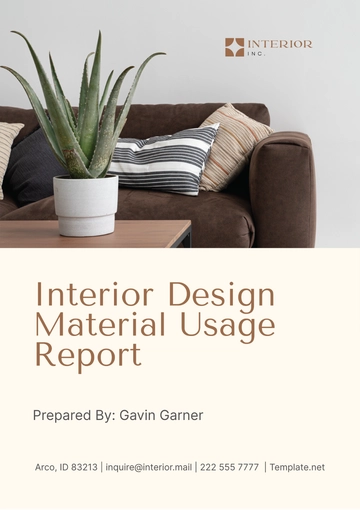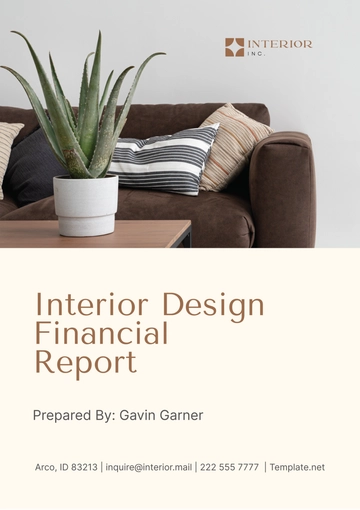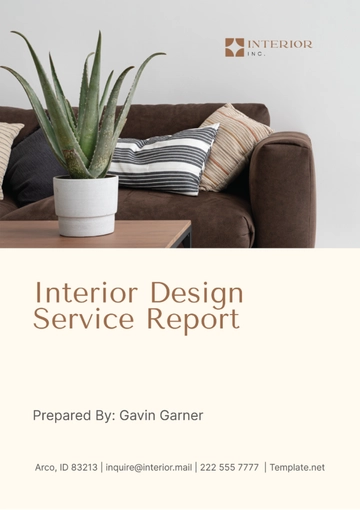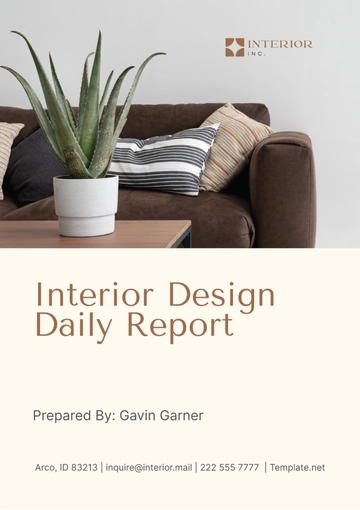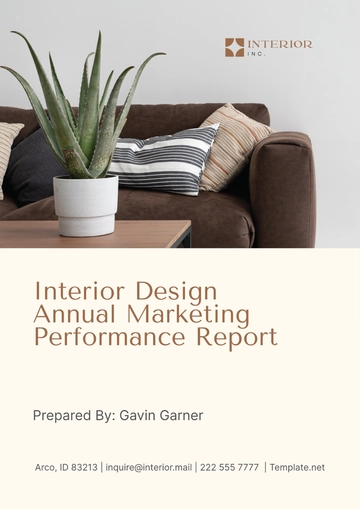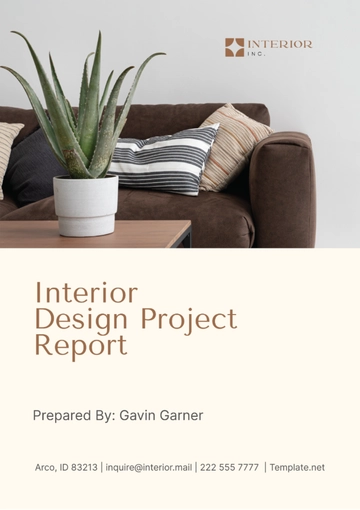Free Interior Design Material Usage Report
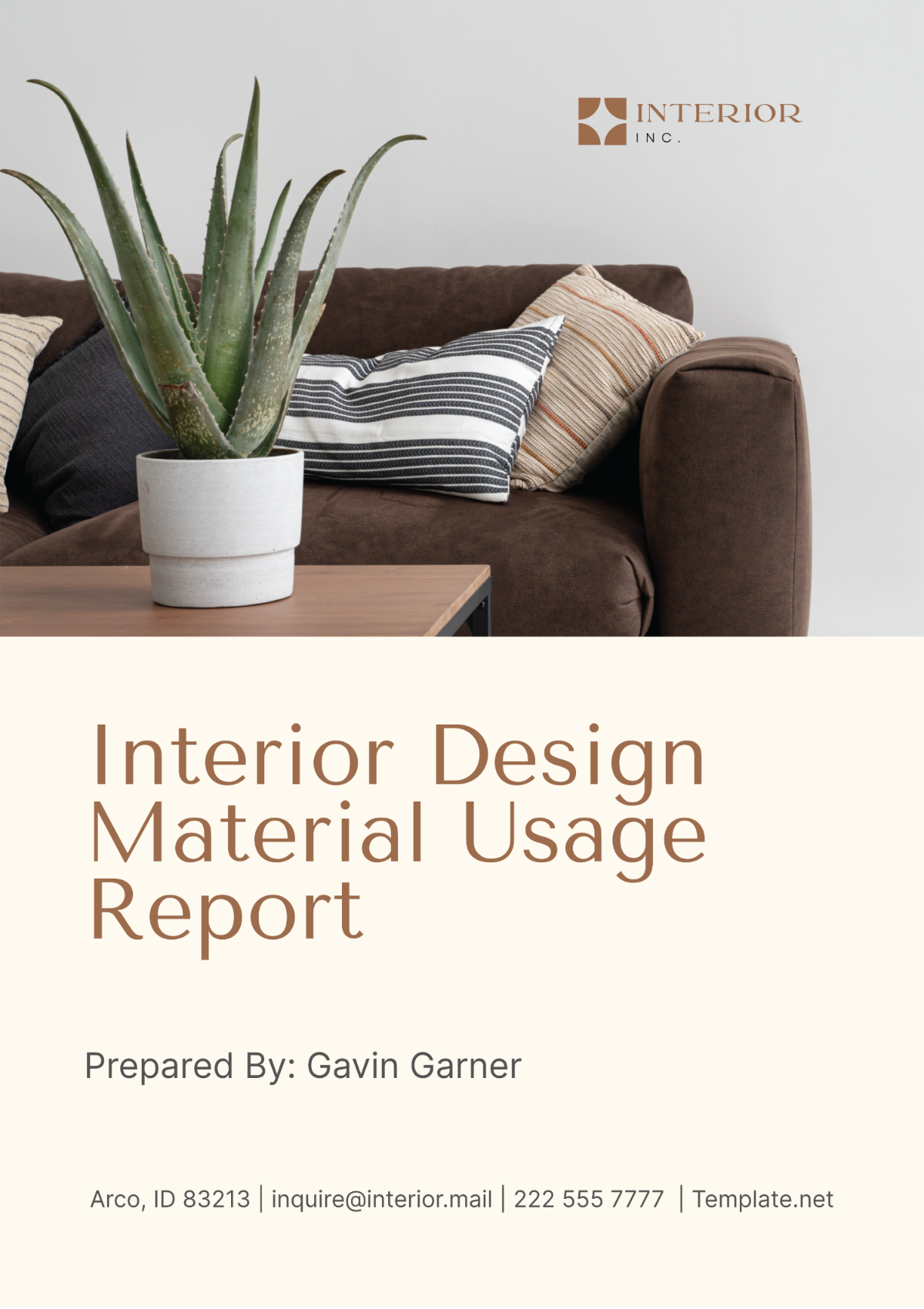
I. Introduction
This report is prepared to assess and analyze the material usage across our interior design projects over the past year. The purpose of this document is to provide a detailed overview of the types and quantities of materials utilized, facilitating better resource management and cost-efficiency in future projects. This report covers all major projects completed between January and December of the previous year, encompassing a range of commercial and residential spaces.
II. Project Overview
During the reporting period, we completed a total of five major projects, including three commercial offices and two residential homes. These projects were located in urban areas, with spaces ranging from 1,500 to 5,000 square feet. Each project was tailored to meet the unique needs and aesthetic preferences of our clients, requiring a diverse range of materials to accomplish our design objectives while adhering to our commitment to quality and sustainability.
III. Material Summary
The following narrative and table summarize the total quantity of each category of materials used in our projects during the reported period. The data is crucial for understanding our inventory needs and cost implications for similar future projects.
Material Type | Total Quantity Used |
|---|---|
Textiles | 2,000 yards |
Metals | 1,500 pounds |
Woods | 3,000 square feet |
Plastics | 500 pounds |
Glass | 1,200 square feet |
Textiles primarily included fabrics used for upholstery, window treatments, and decorative accents. Metals were used in custom furniture and fixtures, while wood was a significant component in furniture and flooring. Plastics were utilized primarily for decorative items and some types of furniture, and glass was extensively used in both residential and commercial spaces for partitions, doors, and decorative elements. This comprehensive usage data helps to manage our procurement strategies and maintain efficiency in material consumption.
IV. Material Usage by Project
This section provides a detailed breakdown of the types and quantities of materials used in each of our five projects during the reporting period, along with their respective costs. Analyzing this data helps us to identify cost-saving opportunities and optimize our resource allocation for future projects. Each project varied significantly in both scope and material requirements, reflecting the bespoke nature of our design solutions.
Numbers 1-5 each corresponds to a project.
Material | 1 | 2 | 3 | 4 | 5 |
|---|---|---|---|---|---|
Textiles (yds) | 200 $1,000 | 300 $1,500 | 400 $2,000 | 250 $1,250 | 850 $4,250 |
Metals (lbs) | 300 $900 | 200 $600 | 400 $1,200 | 150 $450 | 450 $1,350 |
Woods (sq ft) | 500 $2,500 | 600 $3,000 | 800 $4,000 | 400 $2,000 | 700 $3,500 |
Plastics (lbs) | 100 $200 | 50 $100 | 150 $300 | 80 $160 | 120 $240 |
Glass (sq ft) | 200 $500 | 250 $625 | 300 $750 | 180 $450 | 270 $675 |
V. Supplier Information
This section includes details on the suppliers from whom materials were purchased, along with the terms of purchase for each material. This information is crucial for assessing the reliability of our supply chain and exploring opportunities for better terms or alternative suppliers to enhance cost-effectiveness and sustainability in future projects.
Material Type | Supplier | Term of Purchase |
|---|---|---|
Textiles | ABC Textiles Co. | Bulk purchase |
Metals | XYZ Metals Ltd. | Recurring order |
Woods | Woods and Crafts Inc. | One-time purchase |
Plastics | Synthetic Materials LLC | Recurring order |
Glass | Clear View Supplies | Bulk purchase |
VI. Material Efficiency Analysis
A. Material Wastage per Project
The table below provides an overview of material wastage across the five projects. Managing waste is critical for cost control and environmental sustainability.
Numbers 1-5 each corresponds to a project.
Material Type | 1 | 2 | 3 | 4 | 5 |
|---|---|---|---|---|---|
Textiles (yds) | 10 | 15 | 20 | 12 | 25 |
Metals (lbs) | 10 | 5 | 15 | 7 | 18 |
Woods (sq ft) | 25 | 30 | 35 | 20 | 40 |
Plastics (lbs) | 5 | 2 | 8 | 4 | 10 |
Glass (sq ft) | 10 | 12 | 15 | 9 | 18 |
Wastage analysis indicates variability in material loss across projects, pointing to potential inefficiencies in material handling or estimation procedures.
B. Planned Material Usage vs. Actual
Below is the comparison of planned versus actual material usage. This analysis helps us to understand estimation accuracy and areas needing adjustment.
Material Type | Planned | Actual |
|---|---|---|
Textiles (yds) | 1,800 | 2,000 |
Metals (lbs) | 1,300 | 1,500 |
Woods (sq ft) | 2,800 | 3,000 |
Plastics (lbs) | 400 | 500 |
Glass (sq ft) | 1,100 | 1,200 |
The data shows a consistent pattern of underestimation across all material types. This suggests a need for more precise planning and forecasting methodologies.
C. Suggestions for Improvement
To improve material efficiency, we recommend enhancing our initial project scope assessments to better estimate material needs. Investing in better forecasting tools and training our project managers in advanced estimation techniques could reduce wastage and improve cost efficiency. Strengthening partnerships with suppliers could also lead to better pricing and terms, further lowering project costs. Lastly, implementing stricter on-site management practices will help minimize material waste and loss during project execution.
VII. Sustainability and Compliance
Our commitment to sustainability and compliance with U.S. standards is demonstrated through the conscientious selection of materials and suppliers. We ensure that each project aligns with environmental best practices and adheres to the necessary regulations, providing both functional and eco-friendly design solutions.
Textiles: Utilized organic and recycled fabrics; compliant with the U.S. Organic Fiber Processing Standards.
Metals: Sourced from suppliers practicing sustainable mining; materials meet the U.S. EPA standards for environmental safety.
Woods: Employed FSC-certified wood from responsibly managed forests; compliance with the U.S. Lacey Act ensuring legal sourcing.
Plastics: Prioritized the use of recycled plastics; all plastics comply with U.S. standards for recyclability and reduction of harmful additives.
Glass: Used energy-efficient, recycled glass; compliant with U.S. ENERGY STAR standards for environmental performance.
VIII. Financial Impact
The following table details the financial impact of material costs on the overall project budgets, illustrating the relationship between material investment and project revenue.
Project | Material Costs ($) | Project Revenue ($) | Profit Margin (%) |
|---|---|---|---|
Project 1 | 4,600 | 20,000 | 77% |
Project 2 | 5,325 | 22,500 | 76% |
Project 3 | 8,250 | 30,000 | 72% |
Project 4 | 3,860 | 18,000 | 79% |
Project 5 | 9,525 | 35,000 | 73% |
The analysis of the financial impact reveals a robust profit margin across all projects, albeit with slight variations due to the differential material costs. The correlation between higher material expenses and project revenue suggests that investing in higher quality, sustainable materials could potentially yield better financial returns, aligning cost with client satisfaction and environmental impact.
IX. Conclusion
The comprehensive review of our material usage highlights several strengths in our project execution and areas for improvement. Based on our findings, we recommend the following:
Enhance Estimation Accuracy: Implement more sophisticated tools and training to improve the accuracy of material estimations, reducing discrepancies between planned and actual usage.
Strengthen Supplier Relationships: Develop closer partnerships with suppliers to secure better pricing and sustainable material options.
Monitor Wastage: Introduce stricter controls and regular audits to reduce material wastage on site, enhancing overall project profitability.
Invest in Sustainability: Continue investing in sustainable materials and compliance with regulatory standards to not only meet but exceed environmental and safety expectations.
Financial Management: Maintain vigilance over the financial impacts of material choices to balance cost with quality and sustainability.
By adhering to these recommendations, we aim to solidify our reputation for excellence and responsibility in the interior design industry, ensuring long-term profitability and sustainability.
- 100% Customizable, free editor
- Access 1 Million+ Templates, photo’s & graphics
- Download or share as a template
- Click and replace photos, graphics, text, backgrounds
- Resize, crop, AI write & more
- Access advanced editor
Introducing the Interior Design Material Usage Report Template, exclusively on Template.net! Track material consumption effortlessly with this editable and customizable tool. Tailored for interior designers, it offers a detailed breakdown of material usage. Customize it to match your specific needs, all editable in our intuitive AI Editor tool. Simplify your reporting process and allocate more time to refining your creative designs!
You may also like
- Sales Report
- Daily Report
- Project Report
- Business Report
- Weekly Report
- Incident Report
- Annual Report
- Report Layout
- Report Design
- Progress Report
- Marketing Report
- Company Report
- Monthly Report
- Audit Report
- Status Report
- School Report
- Reports Hr
- Management Report
- Project Status Report
- Handover Report
- Health And Safety Report
- Restaurant Report
- Construction Report
- Research Report
- Evaluation Report
- Investigation Report
- Employee Report
- Advertising Report
- Weekly Status Report
- Project Management Report
- Finance Report
- Service Report
- Technical Report
- Meeting Report
- Quarterly Report
- Inspection Report
- Medical Report
- Test Report
- Summary Report
- Inventory Report
- Valuation Report
- Operations Report
- Payroll Report
- Training Report
- Job Report
- Case Report
- Performance Report
- Board Report
- Internal Audit Report
- Student Report
- Monthly Management Report
- Small Business Report
- Accident Report
- Call Center Report
- Activity Report
- IT and Software Report
- Internship Report
- Visit Report
- Product Report
- Book Report
- Property Report
- Recruitment Report
- University Report
- Event Report
- SEO Report
- Conference Report
- Narrative Report
- Nursing Home Report
- Preschool Report
- Call Report
- Customer Report
- Employee Incident Report
- Accomplishment Report
- Social Media Report
- Work From Home Report
- Security Report
- Damage Report
- Quality Report
- Internal Report
- Nurse Report
- Real Estate Report
- Hotel Report
- Equipment Report
- Credit Report
- Field Report
- Non Profit Report
- Maintenance Report
- News Report
- Survey Report
- Executive Report
- Law Firm Report
- Advertising Agency Report
- Interior Design Report
- Travel Agency Report
- Stock Report
- Salon Report
- Bug Report
- Workplace Report
- Action Report
- Investor Report
- Cleaning Services Report
- Consulting Report
- Freelancer Report
- Site Visit Report
- Trip Report
- Classroom Observation Report
- Vehicle Report
- Final Report
- Software Report
